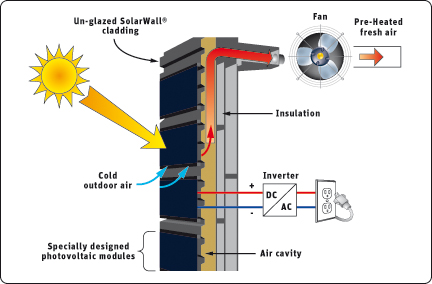This innovation will make the JMSB building a unique demonstration project that puts Concordia on the map as an innovative Canadian university. Graduate students supervised by Solar Network researchers work on related projects as they monitor the performance of the system.
Renewable energy generation using radiation from the sun is usually carried out in two forms; electric generation using photovoltaic cells (PV) and thermal generation heating air or water (T). The delivery of thermal energy at the right time and temperature can be problematic. Heat may not always be needed and during the cold Canadian winter the available heat may not meet the requirements. Converting the sun’s rays to electricity, however, can be 3 to 4 times less efficient than thermal conversion. The combined generation of heat and electricity optimizes the useful energy generated from the sun, producing three times more heat than electricity.
The JMSB building system uses thermal energy to pre-heat fresh air as it enters the building to warm the interior, ensuring that all the thermal solar heat is recovered as usable energy (see below illustration). The fresh air is drawn in around the photovoltaic panels that create the electricity and these are cooled by the incoming cold air. As is commonly known, cooling electrical equipment, such as computer chips, generally increases the electrical performance. The same is true for photovoltaic panels.

Process of pre-heating fresh air as it enters the JMSB building
To help determine the efficiency of the university’s system, and for other research projects, a Kipp & Zonen SOLYS 2 sun tracker will be installed on the roof of the JMSB building in order to measure the available solar radiation. The instruments mounted on the SOLYS 2 will measure both direct & diffuse radiation. Knowing this, researchers can calculate how much of the radiation they are converting into usable energy.
The ability to generate heat and electricity at the site of consumption eliminates the costs and losses inherent in off-site generation, such as transmission losses. But it also provides heat and electricity independence during the building’s construction.
On sunny days during the heating season, large amounts of fresh air can be heated with a temperature increase of about 20°C. This low temperature application of fresh-air heating has high-energy recovery efficiencies, and for institutional buildings such as the JMSB, fresh air is always required. The warmed air is then delivered to the building HVAC system, where it is further heated, if required.
A large amount of the heat supplied to the fresh air is removed from the photovoltaic panels. This heat removal will increase the total number of watts produced by each panel. Typically, the efficiency of the PV panels can be increased by 5% on cold sunny days, compared to a traditional installation. This installation will allow for the production of approximately 110 MW-hr per year, displacing both natural gas and electricity from the grid.
This innovative installation will be continuously monitored, with the help of Kipp & Zonen instruments, to properly quantify the annual energy produced, and to determine the applicability of future projects in Canada.
To learn more about this project please visit: www.solarbuildings.ca.
This information is shared with you by Campbell Scientific Canada, the local distributor of Kipp & Zonen in Canada.